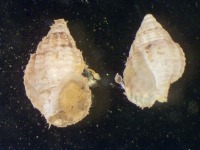
(Photo: Huntsman Marine Science Centre)
Threeline Mud Snail
Ilyanassa trivittata
This snail has a shell with a tall spire and a checkered pattern of raised bumps. It can grow up to two centimetres long. The colouration is grey, brown, or yellow.
Authority
Say, 1822
Classification Details
Phylum: Mollusca (molluscs); Class: Gastropoda (gastropod molluscs, or snails and slugs).
Habitat
Found from the Gulf of St. Lawrence to South Carolina in the intertidal and subtidal zone on sand and mud seabeds. Often found in groups of many individuals.
Diet
Predator. These gastropods can drill holes into other molluscs using their radula: a toothed appendage used for rasping. They then consume the meat inside. They feed on barnacles by prying open top plates to consume the animal inside. Also feed on dead fish.
Reproduction
Separate sexes. Pairs copulate and fertilization is internal. Females lay egg capsules two to four millimetres in height, each containing between 42 and 200 eggs. The eggs develop in the capsule for five to seven days before hatching as veliger larvae. After around 22 days these settle on the seabed and develop into adults.
Fun Facts
Researchers showed the larvae of this species ride waves. When they sense waves, this triggers faster swimming. This behaviour stops them drifting out into the open ocean where they couldn't survive.
References
Chatzinikolaou E (2006) The ecology and growth of the netted dogwhelk Nassarius reticulatus (Gastropoda: Nassariidae). PhD thesis. University of Wales, Wales, UK. Dimon AC (1902) Quantitative Study of the Effect of Environment upon the Forms of Nassa obsoleta and Nassa trivittata from Cold Spring Harbor, Long Island. Biometrika 2(1), 24–43. Fuchs HL, Gerbi GP, Hunter EJ, Christman AJ (2018) Waves cue distinct behaviors and differentiate transport of congeneric snail larvae from sheltered versus wavy habitats. Proceedings of the National Academy of Sciences of the United States of America 115, E7532-E7540. Palomares MLD and Pauly D (2019) Sealife Base. Reproduction of Nassarius trivittatus. https://www.sealifebase.ca/Reproduction/FishReproSummary.php?ID=5521&GenusName=Nassarius&SpeciesName=trivittatus&fc=2012&StockCode=27459 Accessed online 22 January 2020. Pechenik, JA (1975) The escape of veligers from the egg capsules of Nassarius obsoletus and Nassarius trivittatus (Gastropoda, Prosobranchia). Biology Bulletin 149, 150–158. Scheltema RS (1964) Feeding habits and growth in the mud-snail Nassarius obsoletus. Chesapeake Science 5, 161–166. The University of Rhode Island. New England Dog Whelk (Nassarius trivittatus) – Environmental Data Centre. https://www.edc.uri.edu/restoration/html/gallery/invert/new.htm Accessed online 22 January 2020.

